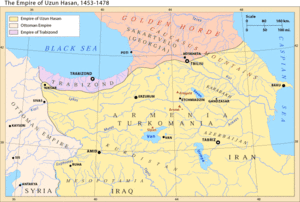Uzun Hasan

Uzun Hasan (1423 - January 6, 1478), (Persian: اوزون حسن) , where uzun means tall) Sultan of the Ak Koyunlu dynasty, or White Sheep Turkmen. Hassan ruled in parts of present-day western Iran, Iraq, Turkey, Azerbaijan and Armenia between 1453 and 1478.
Timur appointed his great-grandfather, Kara Yülük Osman, as a governor of Diyarbakır (in modern-day Turkey), with the cities of Erzincan, Mardin, Roha (or Urfa), and Sivas. Uzun Hasan defeated Jahan Shah, prince of the Kara Koyunlu or Black Sheep Turkmen in 1467.
According to Ambrose Contarini, Venetian ambassador to Uzun-Hassan's court from 1473 to 1476, "The king is of a good size, with a thin visage and agreeable countenance, having somewhat of the Tartar appearance, and seemed to be about seventy years old. His manners were very affable, and he conversed familiarly with every one around him; but I noticed that his hands trembled when he raised the cup to his lips." His name means "tall" and Contarini reported that he was also "very lean."
Contarini also wrote, "The empire of Uzun-Hassan is very extensive, and is bounded by Turkey and Caramania, belonging to the Sultan, and which latter country extends to Aleppo. Uzun-Hassan took the kingdom of Persia from Causa, whom he put to death. The city of Ecbatana, or Tauris, is the usual residence of Uzun-Hassan; Persepolis or Shiras ...[1] , which is twenty-four days journey from thence, being the last city of his empire, bordering on the Zagathais, who are the sons of Buzech, sultan of the Tartars, and with whom he is continually at war. On the other side is the country of Media, which is under subjection to Sivansa, who pays a kind of yearly tribute to Uzun-Hassan. It is said that he has likewise some provinces on the other side of the Euphrates, in the neighbourhood of the Turks. The whole country, all the way to Ispahan... is exceedingly arid, having very few trees and little water, yet it is fertile in grain and other provisions.
"His eldest son, named Ogurlu Mohamed, was much spoken of when I was in Persia, as he had rebelled against his father. He had other three sons; Khalil Mirza, the elder of these was about thirty-five years old, and had the government of Shiras. Jacub beg, another son of Uzun-Hassan, was about fifteen, and I have forgotten the name of a third son. By one of his wives he had a son named Masubech, or Maksud beg, whom he kept in prison, because he was detected in corresponding with his rebellious brother Ogurlu, and whom he afterwards put to death. According to the best accounts which I received from different persons, the forces of Uzun-Hassan may amount to about 50,000 cavalry, a considerable part of whom are not of much value. It has been reported by some who were present, that at one time he led an army of 40,000 Persians to battle against the Turks, for the purpose of restoring Pirameth to the sovereignty of Karamania, whence he had been expelled by the infidels.
Uzun-Hassan met the Ottomans in battle near Erzincan in 1471 and at Tercan in 1473. He was defeated by Mehmed II at Battle of Otluk Beli in the late summer of 1473.[2]
Marriage and children
Uzun Hassan had seven sons: Ogurlu Mohammed, Khahil Mirza, Maksud beg, Jakub beg, Masih beg, Yusuf beg, and Zegnel. In 1458 Uzun Hassan married Theodora Megale Comnena (called Despina Hatun), the daughter of Emperor John IV of Trebizond and his wife Bagrationi.[3] Their daughter Halima married Haydar Safavi Sultan and became the mother of Shah Ismail I[4] of Iran and ancestor of the later Moghul emperors of India.
External links
References
- ^ PROJECT GUTENBERG e-book A General History and Collection of Voyages and Travels, Volume II, by Robert Kerr , PROJECT GUTENBERG
- ^ Babinger, Franz (1978). Mehmed the Conqueror and his Time. Bollingen Series XCVI. ed. by William C. Hickman, trans. by Ralph Manheim. Princeton University Press. pp. 314–315. ISBN 0691099006.
- ^ Profile of Alexios IV and his children in "Medieval Lands" by Charles Cawley
- ^ Roger Savory, "Iran Under the Safavids", p.18
